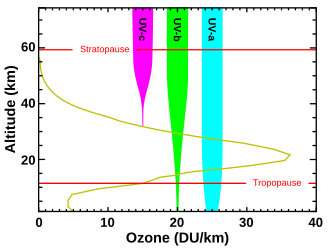Ozone depletion
(Redirected from Ozone hole)
Ozone depletion refers to the thinning and reduction of the ozone layer in the Earth's stratosphere. The ozone layer is crucial for life on Earth as it absorbs the majority of the Sun's harmful ultraviolet (UV) radiation, which can cause skin cancer, cataracts, and other health issues in humans, and also affect other living organisms. Ozone depletion has significant environmental impacts, including effects on climate, ecosystems, and biogeochemical cycles.
Causes
The primary cause of ozone depletion is the release of chlorofluorocarbons (CFCs), halons, and other ozone-depleting substances (ODS) into the atmosphere. These compounds are stable in the lower atmosphere, allowing them to reach the stratosphere, where they are broken down by UV radiation, releasing chlorine and bromine atoms. These atoms then catalytically destroy ozone molecules, leading to thinning of the ozone layer. Sources of CFCs and other ODS include refrigeration, air conditioning systems, foam blowing agents, and aerosol propellants.
Effects
The most well-known consequence of ozone depletion is the increase in UV radiation reaching the Earth's surface. This can lead to higher rates of skin cancer, cataracts, and other health issues in humans. It can also affect wildlife, particularly marine ecosystems where UV radiation penetrates the upper layers of the ocean, affecting phytoplankton, which form the basis of aquatic food webs. Additionally, changes in UV radiation can affect plant growth and crop yields.
Measurement and Monitoring
Ozone concentration in the atmosphere is measured in Dobson Units (DU), which represent the thickness of the ozone layer in a column directly above the measurement point. Satellite instruments, ground-based observations, and balloon sondes are used to monitor ozone levels globally. The most significant decrease in ozone has been observed over the Antarctic, leading to the formation of the so-called "ozone hole" in the late 20th century.
International Response
The discovery of the ozone hole over Antarctica in the 1980s led to international efforts to address ozone depletion. The Montreal Protocol on Substances that Deplete the Ozone Layer was adopted in 1987 and has been ratified by all countries of the world. The protocol controls the production and consumption of CFCs, halons, and other ODS. Its success has led to a decrease in the emissions of these substances and is expected to lead to the recovery of the ozone layer by the middle of the 21st century.
Recovery and Future Challenges
Recent studies suggest that the ozone layer is slowly recovering, thanks to the measures taken under the Montreal Protocol. However, challenges remain, including the potential increase in emissions of some unregulated substances that can also affect the ozone layer. Climate change may also impact the recovery of the ozone layer through changes in atmospheric circulation and temperature.
This article is a environment-related stub. You can help WikiMD by expanding it!
Transform your life with W8MD's budget GLP-1 injections from $125.
W8MD offers a medical weight loss program to lose weight in Philadelphia. Our physician-supervised medical weight loss provides:
- Most insurances accepted or discounted self-pay rates. We will obtain insurance prior authorizations if needed.
- Generic GLP1 weight loss injections from $125 for the starting dose.
- Also offer prescription weight loss medications including Phentermine, Qsymia, Diethylpropion, Contrave etc.
NYC weight loss doctor appointments
Start your NYC weight loss journey today at our NYC medical weight loss and Philadelphia medical weight loss clinics.
- Call 718-946-5500 to lose weight in NYC or for medical weight loss in Philadelphia 215-676-2334.
- Tags:NYC medical weight loss, Philadelphia lose weight Zepbound NYC, Budget GLP1 weight loss injections, Wegovy Philadelphia, Wegovy NYC, Philadelphia medical weight loss, Brookly weight loss and Wegovy NYC
|
WikiMD's Wellness Encyclopedia |
| Let Food Be Thy Medicine Medicine Thy Food - Hippocrates |
Medical Disclaimer: WikiMD is not a substitute for professional medical advice. The information on WikiMD is provided as an information resource only, may be incorrect, outdated or misleading, and is not to be used or relied on for any diagnostic or treatment purposes. Please consult your health care provider before making any healthcare decisions or for guidance about a specific medical condition. WikiMD expressly disclaims responsibility, and shall have no liability, for any damages, loss, injury, or liability whatsoever suffered as a result of your reliance on the information contained in this site. By visiting this site you agree to the foregoing terms and conditions, which may from time to time be changed or supplemented by WikiMD. If you do not agree to the foregoing terms and conditions, you should not enter or use this site. See full disclaimer.
Credits:Most images are courtesy of Wikimedia commons, and templates, categories Wikipedia, licensed under CC BY SA or similar.
Contributors: Prab R. Tumpati, MD






